
Casino Pier is an amusement park situated on a pier, in Seaside Heights, New Jersey. The pier opened in 1932 and formerly extended approximately 300 ft (91 m) into the Atlantic Ocean from the narrow strip of the Barnegat Peninsula, including approximately six blocks within Seaside Heights.

Eastbourne Pier is a seaside pleasure pier in Eastbourne, East Sussex, on the south coast of England.

Southwold Pier is a pier in the coastal town of Southwold in the English county of Suffolk. It is on the northern edge of the town and extends 190 metres (620 ft) into the North Sea.

North Pier is the most northerly of the three coastal piers in Blackpool, England. Built in the 1860s, it is also the oldest and longest of the three. Although originally intended only as a promenade, competition forced the pier to widen its attractions to include theatres and bars. Unlike Blackpool's other piers, which attracted the working classes with open air dancing and amusements, North Pier catered for the "better-class" market, with orchestra concerts and respectable comedians. Until 2011, it was the only Blackpool pier that consistently charged admission.

Llandudno Pier is a Grade II* listed pier in the seaside resort of Llandudno, North Wales, United Kingdom. At 2,295 feet (700 m), the pier is the longest in Wales and the fifth longest in England and Wales. In 2005, was voted "Pier of the Year 2005" by the members of the National Piers Society.

The Grade II listed structure of Mumbles Pier is an 835 feet (255 m) long Victorian pleasure pier built in 1898. It is located at the south-western corner of Swansea Bay near the village of Mumbles, within the city and county of Swansea, Wales. The pier is used for fishing and tourism, offering panoramic views of Swansea Bay with the Mumbles Lighthouse on one side and Port Talbot on the other.

The South Parade Pier is a pier in Portsmouth, England. It is one of two piers in the city, the other being Clarence Pier. The pier once had a long hall down its centre which housed a seating area and a small restaurant. The outside of the hall is a promenade which runs the length of the pier. Once fallen into disrepair, as of 2017, the pier has been developed into an amusement arcade and food outlet.

Victoria Pier is a pier in the seaside resort of Colwyn Bay, Wales. The pier fell into disrepair and much of it was demolished, it was reopened in 2021 with a reduced length. Visitors can access the pier and see the bay along its length. Some of the original metalwork remains and retains the legal status of a grade-II listed structure.

Paignton Pier is a pleasure pier in the large English seaside resort of Paignton, Devon. It was financed by Arthur Hyde Dendy, a local Paignton barrister and designed by George Soudon Bridgman.

Sandown Pier is a pleasure pier in Sandown, Isle of Wight, England.
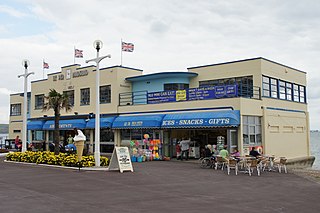
Pier Bandstand Weymouth is an Art Deco bandstand on the shore of Weymouth Bay in Dorset, England.

The Royal Pier, Aberystwyth is a pleasure pier located in Aberystwyth, Ceredigion, Wales. The first pier to open in Wales (1865), after a series of heavy storms it is now a much shortened version of its originally constructed length of 242 metres (794 ft).
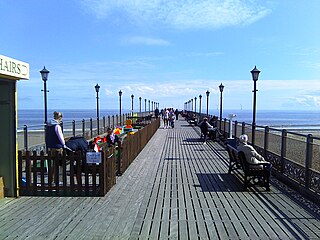
Skegness Pier is a pleasure pier in Skegness, Lincolnshire, England. Opened in June 1881, it was at the time the fourth longest in England, originally stretching a length of 1,844 ft (562 m). When originally built, it was a T-shaped pier with a saloon/concert hall at the pier head. Steamboat trips ran from the pier to Norfolk until 1910.

St Annes Pier is a Victorian era pleasure pier in the English seaside resort of St Annes-on-the-Sea, Lancashire. It lies on the estuary of the River Ribble. The pier, designed by Alfred Dowson, was completed in 1885 and was one of the earliest public buildings in St Annes, a 19th-century planned town. The pier was originally intended to be a sedate promenading venue for the resort's visitors, but attractions were later added. Changes made to the estuary channels to improve access to Preston Dock left the pier on dry land and ended its steamer services to Blackpool and Liverpool.
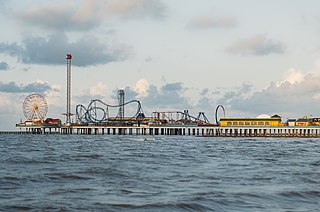
Galveston Island Historic Pleasure Pier is a pleasure pier in Galveston, Texas, United States. Opened in the summer of 2012, it has 1 roller coaster, 15 rides, carnival games and souvenir shops.
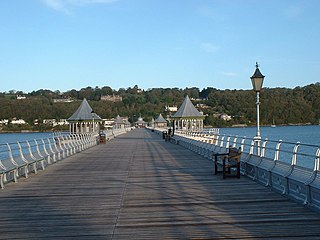
Garth Pier is a Grade II listed structure in Bangor, Wales. At 1,500 feet (460 m) in length, it is the second-longest pier in Wales, and the ninth longest in the British Isles.

Penarth Pier is a Victorian era pier in the town of Penarth, Vale of Glamorgan, South Wales. The pier was opened in 1898 and was a popular attraction to seaside-goers at the time, who also enjoyed trips on pleasure steamers that operated from the pier. It has on several occasions been damaged by vessels colliding with the structure and in 1931, a fire broke out in one of the pavilions. This wooden pavilion was never replaced, but a concrete pavilion has been used over the years as a concert hall, ballroom, cinema and for other purposes. It is currently home to the Penarth Pier Pavilion.
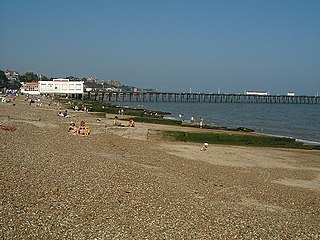
Felixstowe Pier is a pleasure pier in the Edwardian seaside town of Felixstowe, Suffolk, England. The pier opened in August 1905 with a total length of 2,640 feet (800 m) and was once one of the longest in the country. Steamer services operated from the pier to various destinations. The pier was never served by its own railway station, the confusion arising because of a now demolished or buried pier located elsewhere in Felixstowe.
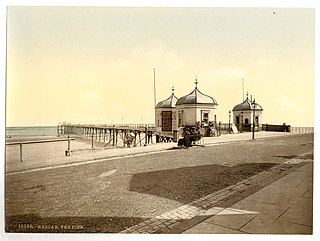
Redcar Pier was a Victorian pleasure and landing pier constructed on The Esplanade in the seaside town of Redcar on the north east coast of Yorkshire, England.
South Pier is a leisure pier in Lowestoft, Suffolk, engineered by William Cubitt and opened in 1846 at a length of 1,320 feet (400 m). The pavilion was used by the Royal Naval Patrol Service as a headquarters during World War I, although it suffered significant damage during World War II and was subsequently demolished.





















